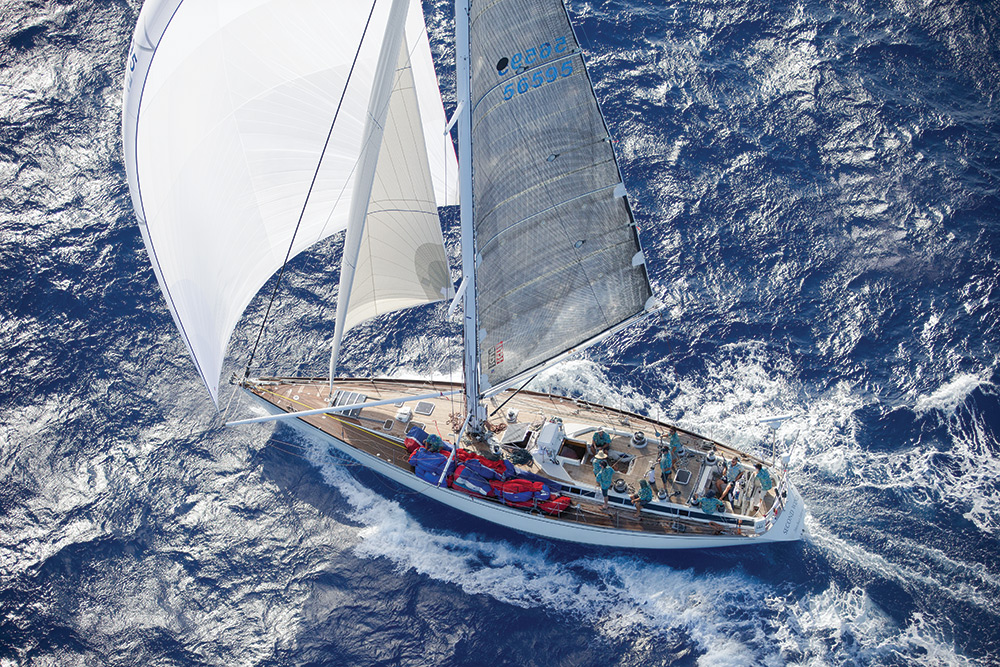Onward to Hawaii

Reality television show producers could not have dreamed up a more cockamamie set of obstacles than what the 2015 Transpacific Yacht Race served its 60 entrants, racing from Los Angeles, California, to Honolulu, Hawaii, in July. During the last of three starts there was rain, thunder and lightening—unheard of in California mid-summer. A hurricane threatened; the fleet was becalmed. Fires, failures and things-that-go-bump-in-the-night peppered the course. And if that wasn’t enough, during two of the busiest nights for arrivals, entrance to the Ala Wai Marina was shut by a raucous south swell that rolled huge breakers down the channel. Dozens of racers, eager for the traditional greeting of mai tais and leis, were forced to stand off until dawn.
“It was a trip to the Twilight Zone,” said Randy Smith, who was racing his ninth Transpac, aboard the Santa Cruise 70 OEX. The crew compared the experience to the movie “Pulp Fiction,” saying conditions at the beginning and end were flopped. “We were VMG running with the 2A, right after the start, and hard-reaching with a jibtop on the last day.”
In between, the crew dodged an unprecedented amount of floating debris when they could. At one point, barreling along at 16 knots, they collided with a net so hard, “We thought we hit a whale,” he said. Abruptly stopped, they had no choice but to douse the spinnaker and back down, mid-ocean.
Four other boats returned to port with breakdowns, including the 49-foot Jeanneau Vivacia that took on water, then suffered an electrical short and fire that wiped out their electronics. A compass guided them home.
Joel Young and his crew of Transpac virgins aboard the Aloha Class entrant Transformer lost their navigation systems too.
“It was rough the first week,” said Young, who had envisioned a sweet spinnaker ride down long voluptuous swells. “We took a bashing! And after that, it got worse. There were times we wondered ‘Is this ever going to end?’”
But there were great times too, he said.
“Sailing really well, really fast, and then times we solved problems on the fly, which was just as rewarding,” Young said upon arriving at the Diamond Head finish. “I was overcome by the emotion of completing the race, and being one of the people lucky enough to do the Transpac.”
Merry Cheers, racing on the Jeanneau Sleeper, was a “Waikiki Widow” for nearly a decade, as she had waited ashore while her husband Sam Heck competed many times.
“As a competitive sailor, the Transpac was one of the races I wanted to have under my belt,” Cheers said. “When I got this opportunity I jumped at it!”
“I knew there would be challenges,” added Cheers, who has done two boat deliveries home and knew what to expect. Still, the nefarious Transpac 2015 threw out the gauntlet, “By Day 5 I was saying, ‘Why the hell did I want to do this? I am going to fly over the next time!’”
Seas were confused, the wind capricious. And along the way, “a lot of things broke,” including their boom, in an accidental jibe. The boat finished with a jury-rigged main, yet held onto second in class.
“We were full throttle racing all the time, with not much sleep,” but the challenges were offset by the benefits of seeing shooting stars and whales, and driving through the squalls. “I drove through my first serious squall and that experience was hard to beat. It was satisfying, and a lot of fun.”
“I am super proud of Merry,” added her husband Heck, who raced aboard the Santa Cruz 52 Paranoia in Division 5. A veteran of “I can’t remember how many” Transpacs, Heck declared conditions “super-weird.”
“The ocean is vast, but it was amazing how much junk was out there. Plastic everywhere,” he said. They slalomed through the debris, snagging some. “During the race, I swore I would never do this again.”
But then, that “sailor’s amnesia,” as Cheers called it, kicked in. “We would
love to race it together. It’s an
awesome adventure.”
Overall winner in IRC was James McDowell’s Santa Cruz 70 Grand Illusion, which has now equaled the record for most overall Transpac wins, joining the 88-foot Lurline that won the first two races in 1906 and 1908, and again in 1912.
“There’s no better place in the world to finish a sailboat race,” Smith said. “We have a fellowship of people who do the race, and reconvene every two years, and it’s really awesome to be part of something like that.”

Comments